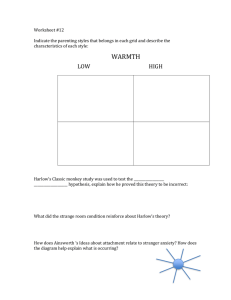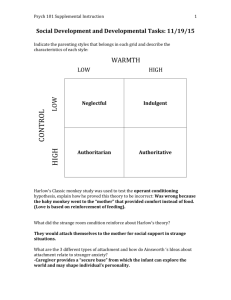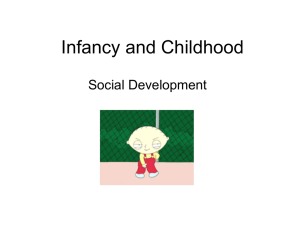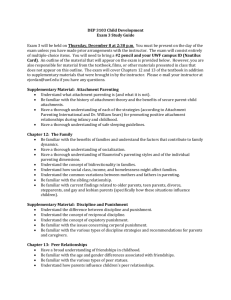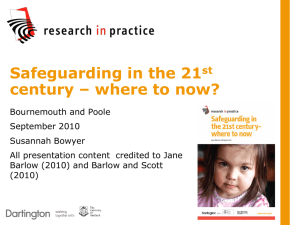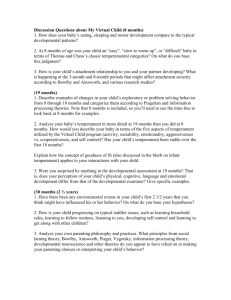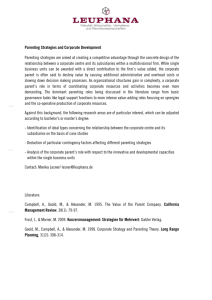Early Social Development
advertisement
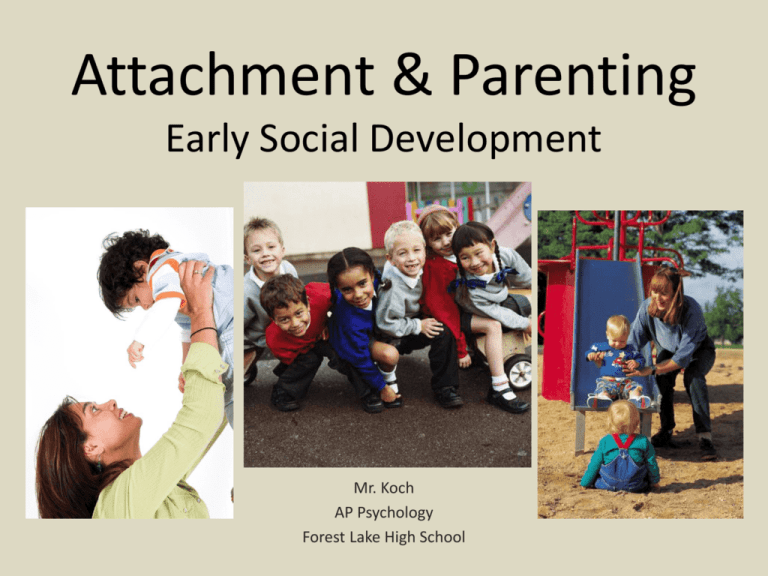
Attachment & Parenting Early Social Development Mr. Koch AP Psychology Forest Lake High School Attachment • A deep and enduring relationship with the person with whom a baby has shared many experiences • Typically begins forming during 1st year of life – John Bowlby • British psychoanalyst drew attention to importance of attachment after observing depression and other emotional scars in children orphaned in WWII – Inspired researchers to study how attachments are formed and what happens when they’re absent or broken Imprinting Konrad Lorenz (1937) • Some animals (i.e. ducks, geese) develop attachment during a “critical period” shortly after birth – Imprinting – instinctively becomes attached to first moving thing seen at this time Konrad Lorenz - Imprinting Harry Harlow (1959) • Tested two opposing hypotheses on what leads to developing attachment: 1. Attachment occurs because mothers feed their babies 2. Attachment is based on the warm, comforting contact from the mother Harlow Monkey Studies clip #1 Harlow Monkey Studies clip #2 Harlow Monkey Studies • Also investigated what happens when attachments do not form – Isolated some newborn monkeys from all social contact – dramatic disturbances after one year • When visited by normal monkeys, huddled in corner and rocked • Unable to have normal sexual relations • Artificially inseminated females tended to ignore own babies – Would sometimes abuse/kill them when babies were distressed • Tragically similar situations observed in Romanian and Russian orphanages Harlow Monkey Studies Mary Ainsworth (1978) (student of John Bowlby) • “Strange Situation” experiment – Infant interacts with mother and stranger in unfamiliar room • Plays with both → mother leaves briefly → baby alone briefly → mother returns Mary Ainsworth – “Strange Situation” • “Secure Attachment” – most infants – Use mother as home base, leave side to explore, but return periodically for comfort/contact – When mother returns from separation, infant happy to see her and receptive to contact Mary Ainsworth – “Strange Situation” • “Insecure Attachment” 1. Avoidant – avoid or ignore mother upon return 2. Ambivalent – upset when mother leaves, switch between clinging and angrily rejecting mother upon return 3. Disorganized – behavior is inconsistent, disturbed, and disturbing (i.e. – cry after mother returns and comforts; reach out for mother while looking away from her) • Secure attachments correlated with more positive social relationships later in life Mary Ainsworth – “Strange Situation” Parenting Styles Parenting Styles • Authoritarian – Strict, punitive, unsympathetic • Value obedience from child and authority for selves • Try to curb child’s will, discourage independence • Detached and seldom praise – Their children tend to be: • Unfriendly, distrustful, withdrawn, less empathic, more aggressive, more likely to cheat, less likely to feel guilty or accept blame Parenting Styles • Permissive – More affectionate, give lax discipline, great deal of freedom – Children tend to be: • Immature, dependent, unhappy, prone to tantrums, act helpless Parenting Styles • Authoritative – Fall between previous two extremes • Reason with child, encourage give and take, sets limits but encourages independence, firm but understanding, demands are reasonable and consistent, give children more responsibility as they mature – Children tend to be: • Friendly, cooperative, self-reliant, socially responsible, better in school, more popular Parenting Styles • Uninvolved – Indifferent to their children • Invest as little time, money, effort as possible • Focus on own needs before child’s – Children tend to be: • Less likely to form secure attachments, more impulsive, aggressive, noncompliant, moody, low in self-esteem Parenting Styles • But, research is correlational – Does parenting cause traits in child? or do child’s traits influence parenting style used by parents?
